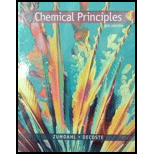
a.
Interpretation: The
Concept Introduction:The measure of energy per unit charge which is available from the
Nernst equation gives the relationship between standard reduction potential,
Where
This equation is specified at room temperature,
a.
Answer to Problem 132MP
The
Explanation of Solution
Given:
The half-reactions at which galvanic cell is based on:
The concentration of
The observed
The half-reactions at which galvanic cell is based on:
Since, the reduction potential value of copper is greater than that of vanadium so, the copper will undergo reduction and vanadium will undergo oxidation so, the half-reactions are written as:
Adding both the reactions to get the overall reactions as:
So, the overall balanced reaction for the galvanic cell is:
Now, according to Nernst equation at room temperature,
Now, the concentration of
The initial moles of
The concentration of
Substituting the values:
Now, substituting the values in equation (1) as:
Hence, the
b.
Interpretation: The value of equilibrium constant for the titration reaction needs to be calculated.
Concept Introduction: The relationship between reactants and products of a reaction in equilibrium with respect to some unit is said to be equilibrium expression. It is the expression that gives ratio between products and reactants. The expression is:
b.
Answer to Problem 132MP
Explanation of Solution
The given titration reaction is:
The expression for equilibrium constant is:
From the balanced reaction, the number of moles of reactants are same that is 1 mole for each so, the equilibrium concentration of both the reactants is same that is
At equilibrium, the number of moles of
Substituting the values:
Now, the concentration of
Substituting the values:
The values of concentrations are substitute in equation (2) as:
c.
Interpretation: The
Concept Introduction: The measure of energy per unit charge which is available from the redox reactions to carry out the reaction is said to be cell potential.
Nernst equation gives the relationship between standard reduction potential,
Where
This equation is specified at room temperature,
c.
Answer to Problem 132MP
The
Explanation of Solution
The volume added to
At hallway equivalence point, the initial moles of
The concentration of
Substituting this value of concentration is Nernst equation as:
Hence, the
Want to see more full solutions like this?
Chapter 11 Solutions
CHEM.PRINC.W/OWL2+REBATE+2 SUPPL.>IP<
- An electrolysis experiment is performed to determine the value of the Faraday constant (number of coulombs per mole of electrons). In this experiment, 28.8 g of gold is plated out from a AuCN solution by running an electrolytic cell for two hours with a current of 2.00 A. What is the experimental value obtained for the Faraday Constant?arrow_forwardGiven this reaction, its standard potential, and the standard half-cell potential of 0.34 V for the Cu2+ |Cu half-cell, calculate E° for the Fe(s)|Fe2+(aq) half-cell.arrow_forwardCalculate the cell potential of a cell operating with the following reaction at 25C, in which [MnO4] = 0.010 M, [Br] = 0.010 M. [Mn2] = 0.15 M, and [H] = 1.0 M. 2MNO4(aq)+10Br(aq)+16H+(aq)2MN2(aq)+5Br2(l)+8H2O(l)arrow_forward
- Calculate the cell potential of a cell operating with the following reaction at 25C, in which [Cr2O32] = 0.020 M, [I] = 0.015 M, [Cr3+] = 0.40 M, and [H+] = 0.60 M. Cr2O72(aq)+6I(aq)+14H+(aq)2Cr3+(aq)+3I2(s)+7H2O(l)arrow_forwardHalide ions can he deposited at a silver anode, the reaction being Ag(s) + X- AgX(s) +e- Suppose that a cell was formed by immersing a silver anode in an analyte solution that was 0.0250 M Cl-,Br-, and I -ions and connecting the half-cell to a saturated calomel cathode via a salt bridge. (a) Which halide would form first and at what potential? Is the cell galvanic or electrolytic? (b) Could I- and Br- be separated quantitatively? (Take 1.00 l0-5 M as the criterion for quantitative removal of an ion.) If a separation is feasible, what range of cell potential could he used? (c) Repeat part (b) for I- and Cl-. (d) Repeat part (b) for Br- and Cl-.arrow_forwardAn alloy made up of tin and copper is prepared by simultaneously electroplating the two metals from a solution containing Sn(NO3)2 and Cu(NO3)2.If 20.0% of the total current is used to plate tin, while 80.0% is used to plate copper, what is the percent composition of the alloy?arrow_forward
- A half-cell that consists of a copper wire in a 1.00 M Cu(NO3)2 solution is connected by a salt bridge to a solution that is 1.00 M in both Pu3+ and Pu4+, and contains an inert metal electrode. The voltage of the cell is 0.642 V, with the copper as the negative electrode. (a) Write the half-reactions and the overall equation for the spontaneous chemical reaction. (b) Use the standard potential of the copper half-reaction, with the voltage of the cell, to calculate the standard reduction potential for the plutonium half-reaction.arrow_forwardThe cell potential of the following cell at 25C is 0.480 V. ZnZn2+(1M)H+(testsolution)H2(1atm)Pt What is the pH of the test solution?arrow_forwardAt 298 K, the solubility product constant for solid Ba(IO3)2 is 1.5 109. Use the standard reduction potential of Ba2+(aq) to find the standard potential for the half-reaction Ba(IO3)2(s)+2eBa(s)+2IO3(aq)arrow_forward
 ChemistryChemistryISBN:9781305957404Author:Steven S. Zumdahl, Susan A. Zumdahl, Donald J. DeCostePublisher:Cengage Learning
ChemistryChemistryISBN:9781305957404Author:Steven S. Zumdahl, Susan A. Zumdahl, Donald J. DeCostePublisher:Cengage Learning Chemistry: An Atoms First ApproachChemistryISBN:9781305079243Author:Steven S. Zumdahl, Susan A. ZumdahlPublisher:Cengage Learning
Chemistry: An Atoms First ApproachChemistryISBN:9781305079243Author:Steven S. Zumdahl, Susan A. ZumdahlPublisher:Cengage Learning
 Principles of Modern ChemistryChemistryISBN:9781305079113Author:David W. Oxtoby, H. Pat Gillis, Laurie J. ButlerPublisher:Cengage Learning
Principles of Modern ChemistryChemistryISBN:9781305079113Author:David W. Oxtoby, H. Pat Gillis, Laurie J. ButlerPublisher:Cengage Learning Chemistry: Principles and ReactionsChemistryISBN:9781305079373Author:William L. Masterton, Cecile N. HurleyPublisher:Cengage Learning
Chemistry: Principles and ReactionsChemistryISBN:9781305079373Author:William L. Masterton, Cecile N. HurleyPublisher:Cengage Learning





